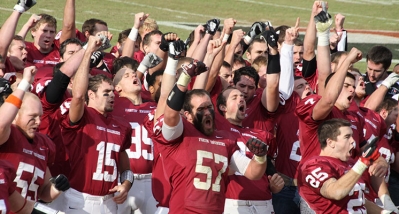By Brian White
Offensive Line Coach
Rose Hulman Institute of Technology
Twitter: @CoachWhite_RHIT
Introduction
 At Rose-Hulman, our offense is predicated on running simple play concepts and executing them as fast as we possibly can. As with most Spread offenses, we also want to make the defense defend the entire width of the field at all times. This is one of the reasons why Outside Zone has become a staple of our offense. We can run this concept in one direction with a Run Adjustment, such as a Bubble or Smoke screen, in the opposite direction. While I will detail our “one word play packages” in another report, I wanted to give as much detail as possible in how we block the outside zone, one of our most productive play concepts.
At Rose-Hulman, our offense is predicated on running simple play concepts and executing them as fast as we possibly can. As with most Spread offenses, we also want to make the defense defend the entire width of the field at all times. This is one of the reasons why Outside Zone has become a staple of our offense. We can run this concept in one direction with a Run Adjustment, such as a Bubble or Smoke screen, in the opposite direction. While I will detail our “one word play packages” in another report, I wanted to give as much detail as possible in how we block the outside zone, one of our most productive play concepts.
Outside Zone
Our Outside Zone is a true zone concept. The offensive line will be responsible for their play side gap. We feel that a true zone concept, as opposed to a Pin & Pull concept, is the most effective manner to handle the variety of fronts, stunts and pressures we encounter each week. We keep the blocking assignments simple for the offensive line, which allows us spend more time developing their technique. The offensive line will reach the defender in their play side gap. The first offensive lineman without a first-level defender in his play side gap will block the play side LB, as the next offensive lineman without a play side defender in his gap will block the backside LB.

The ball carrier is reading the block of the end man on the line of scrimmage (EMOL) as he runs towards the “Read Spot,” which is the roughly spot on the field two yards outside of the EMOL. We talk to our running backs about where the Read Spot is based on the direction of the play. When running Outside Zone to the boundary, the Read Spot is about halfway between the hash and the inside edge of the numbers (what we call the “Logo”). When running the play to the field, the Read Spot is in the middle of the field. Obviously, adjustments must be made if you are playing with high school hashes. He will run at 85% speed (this is a made up number, we use 85% to indicate that the ball carrier should not run full speed while not jogging either). This allows the ball carrier to put the offensive line on their blocks, as a ball carrier that runs too fast will overrun the blocking scheme. Great emphasis must be placed on the ball carrier making his decision on the Read Spot. A cut made before the Read Spot will give the defensive pursuit time to react to the cut and tackle the ball carrier.
Once the ball carrier has arrived at the Read Spot, the EMOL will have either captured the edge or not. If the edge is captured, the ball carrier will accelerate and attack the edge at full speed. If the edge is not captured, the ball carrier will put his play side foot into the ground and “up-cut” at full speed. Emphasizing the up-cut is critical, as a ball carrier that cuts back is likely to run into and unblocked defender pursuing the play.
Play side Reach Technique
A covered Offensive Lineman on the play side will execute a reach block. We call his first step a “Bracer” step. This step gains width and depth aiming outside of the defender’s play side foot. The second step will aim down the middle of the defender. Our striking surface is a “single under (palm facing up) one hand punch with the backside arm aiming at the defender’s sternum. The play side arm should remain free throughout the entire block. Once contact is made, the blocker must work to get his pads square to the line of scrimmage. If the blocker cannot reach the defender, he will then torque the defender outside by flexing his inside oblique and taking the defender past the Read Spot.









